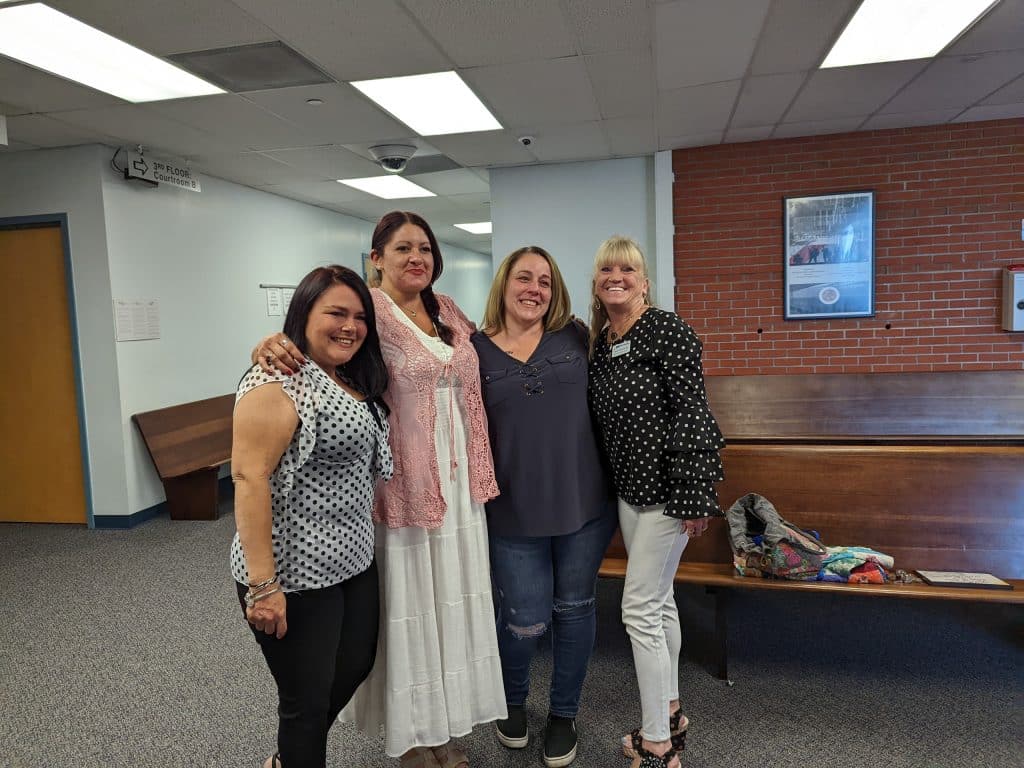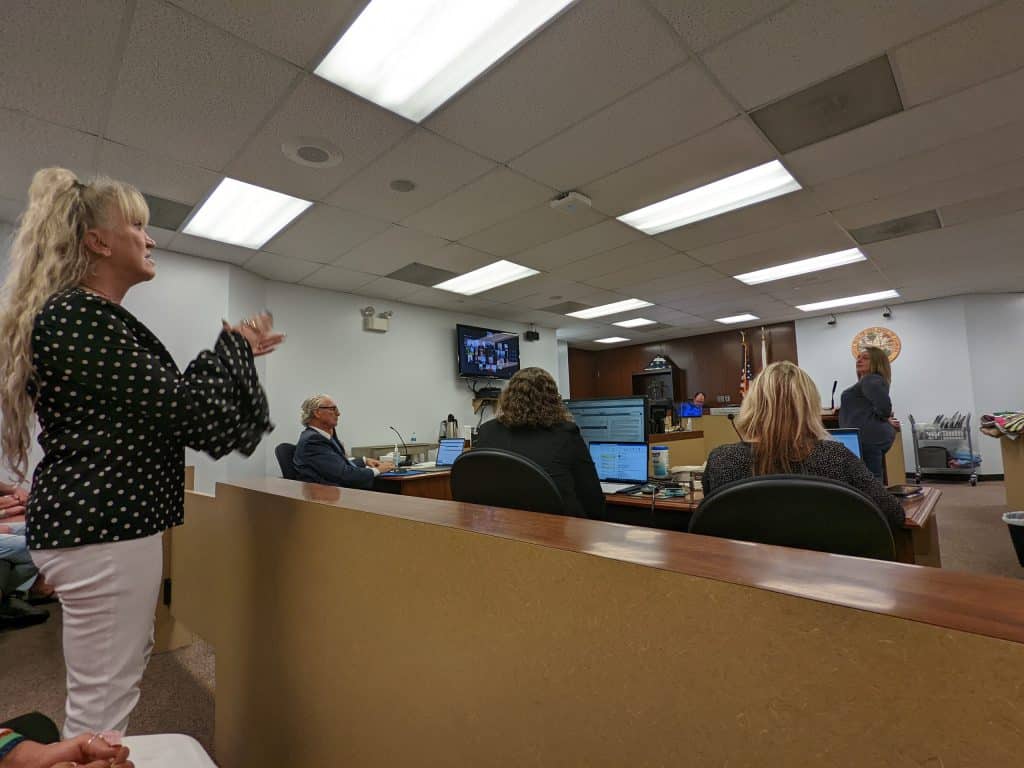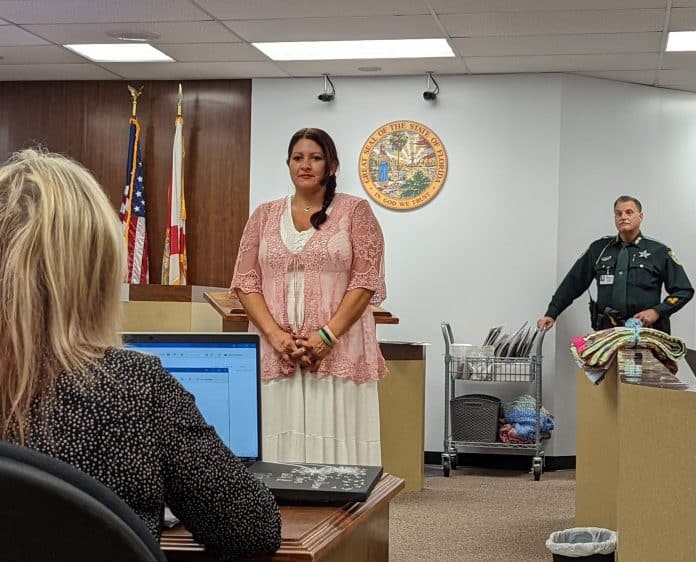For approximately 22 years, Hernando County has been fortunate to have a judicial program that gives non-violent drug offenders the opportunity to avoid jail time through rehabilitation. The Drug Court program is not easy. Participants have to stay clean, show up to required meetings, hearings, and therapy sessions, and submit regular drug screens. Overcoming personal obstacles like addiction or depression is probably the toughest part, but those who make it through gain a new lease on life.
.
The types of non-violent drug offenses that qualify a participant for drug court are many and range from Felony possession of a controlled substance, conspiracy to/ attempt of/solicitation of purchasing a controlled substance, to Conspiracy to obtain a prescription by fraud.
Presiding over drug court on April 21 was Judge Don Barbee Jr. He advised the roughly 30 drug court participants during a recent drug court hearing, “There are three rules in this program: We want you to show up, work hard, and tell the truth. That does not just mean in court. That means for each part of this process. Some of the people today are going to end up being sanctioned for one reason or another. Because they’re not following those very straightforward rules.”
The program consists of four phases and each phase consists of a certain number of substance abuse peer support group meetings, individual/group therapy sessions, random urine testing, and court status hearings. Phase I (8 weeks minimally) focuses on establishing a foundation of abstinence. Phase II (22 weeks minimally) aims to stabilize the individual during treatment, and challenges them to confront the underlying issues surrounding addiction. Phase III (22 weeks minimally) promotes continued CHANGE towards self-sufficiency while reconnecting with the community. The phase called Aftercare is up to 26 weeks and is specifically designed for each program participant according to their need. During this phase, participants develop a life plan focusing on relapse prevention and participate in three community service events. To be considered for graduation, participants must have six consecutive months with no jail sanctions, or dirty (unexcused/ missed/diluted) screens immediately prior to graduation and financial obligations to the program must be met.
“You need to show up for your appointments providers. You engage with the services that we have. This program has a boatload of resources available to you. But you got to want to be here and you’ve got to want to go in that direction,” said Judge Barbee.
Program resources include counseling/therapy services through Baycare, Perspectives, and Solace; as well as individualized peer support services through NAMI Hernando.
Tina Kinney, Executive Director, NAMI Hernando Inc works closely with program participants.
Kinney explains, “NAMI Hernando provides peer support to Hernando County Drug Court participants. Peer support has been defined as “offering help, based on the shared understanding, respect, and mutual empowerment between people in similar situations” (Mead, Hilton, & Curtis, 2001). The belief that recovery is possible for individuals with behavioral health challenges is fundamental to peer support, as is the concept of the development of a mutually beneficial relationship between individuals with similar life experiences. Individuals who have experienced mental illness, substance use disorders, and trauma have a unique capacity to support each other based on these shared experiences. Research shows the effectiveness of peer support on many levels, including increasing engagement in treatment and recovery, promoting a sense of hope and self-empowerment, improving social functioning and overall quality of life, and decreasing hospitalizations (Davidson, Bellamy, Guy, & Miller, 2012).”
Kinney remarked, “Our goal is to help program participants find their pathway to recovery by helping them navigate the behavioral health system, connect them to community resources, inspire hope and successfully complete all the program requirements. When they hit a bump in the road we not only help them create an action plan to overcome the obstacle but we help them recognize how they can avoid it in the future. This leads to long term recovery and reduces recidivism.”
Yet drug court doesn’t work for everyone.
“If you want to get sentenced and do your time, then this is the wrong place,” Judge Barbee told the participants.
Amy Balwin, Problem Solving Courts Coordinator/Supervisor for the Fifth Judicial Circuit told Hernando Sun, “We can’t want it for them more than they want it for themselves.”
The drug offenders must enter a guilty plea before entering the program. It takes an offender typically 15-24 months to finish the program. If they successfully graduate, the court dismisses all charges.
“If you want to get sentenced and do your time, then this is the wrong place. If you want people that are going to help you, be surrounded by resources and really want to get better from whatever the thing is that’s troubling you right now, then we are the place for you,” said Barbee.
On April 21, three program participants graduated. Each graduate was addressed by the various people in the program that helped them to achieve this goal. Then their program score sheet was ripped up and Judge Barbee was asked to dismiss the affidavit of violation. They were all sent off with quilts and other tokens of congratulations.

Before graduation day, Graduate Melissa Bonner had never met her co-graduate Angelica Vilardo in person as previous drug court sessions have been conducted virtually.
She told Angelica, “I’d just like to say how proud I am of you. We’ve never met, but I’ve watched you up there on the tv when I’m not in court and two times ago when you’re like I’m a year clean- I started crying.”
She said that every time she did something great, she’d cheer for her, even though Angelica couldn’t see her.
Angelica told Melissa, “That means a lot to me, thank you.”
Angelica explained that she had been using and drinking since the age of nine. She reached a breaking point when she found her mother hanging on her birthday.
“So she took her life and that sent me over the edge. I was completely ready to die at that time.”
Angelica got arrested for battery on an officer and faced a five-year prison sentence.
“If I hadn’t have gotten in trouble, I wouldn’t have stopped,” she said.
“The (drug court) programs, NAMI, how amazing probation was, Amy and the judge, Matt Fox, the therapist at BayCare- they’re all amazing- they’re cheerleaders.”
Yet, her transformation took time. A year into the program she told her sponsor, “When this is over I’m gonna drink, I’m gonna use.”
“But that didn’t happen,” she said. “I waited. And now I don’t ever want to do that again.”
“It saved my life and it saved everybody around me a lot of grief.”
After Melissa was arrested she pushed for mental health support. She told the judge, “I want mental health court. I’ve tried to kill myself four times.”

remarks upon her
graduation from drug court, April 21, 2022.
“Four times.” Pointing to a scar on her wrist she said, “This time in front of my three-year-old grandson.”
She entered the drug court program.
“So this helped me a lot. They know what they’re talking about. You surround yourself with people that have the same issues, so you know how to get through them. And they’re all very understanding.”
“It’s not difficult, just do what you’re supposed to do- tell the truth.”
Early on she didn’t feel it was the right time for her to move to the next phase of the program because she had gone through several medication changes.
“I wasn’t ready. I came into this program for help, not because I didn’t want to go to jail or prison. I came into the program to get the help that I needed.”
“So I’ve been on the program a little longer than everybody else because of that, but it was the best decision I made.”

